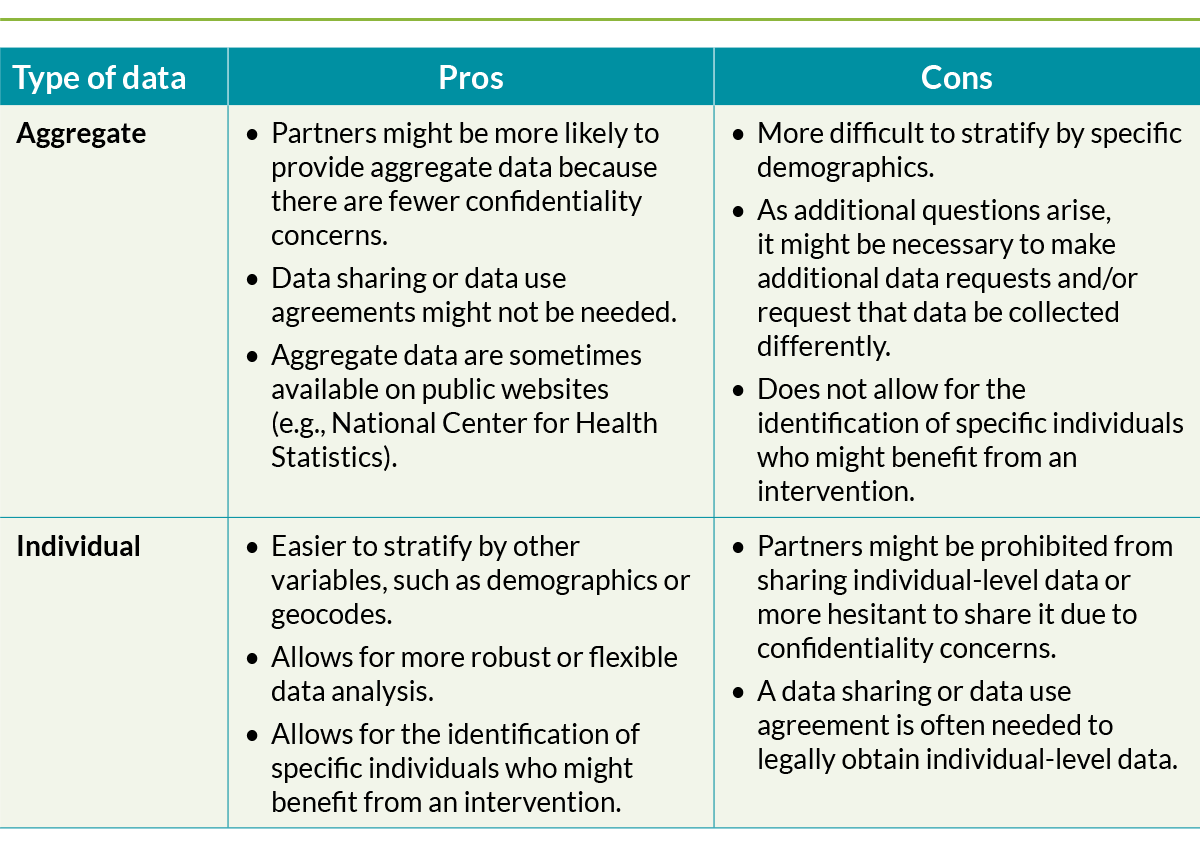
There are no modules in this training course.
Next steps
What are potential next steps for collecting and using data on school attendance, disciplinary actions, and readiness to assess and improve CAMH? Health departments can use aggregate-level data to compare trends over time, compare schools or school districts across a larger jurisdiction, and identify schools or school districts that are experiencing an increase in school absences – each of which may indicate a need for mental health support. Some health departments might also be interested in obtaining individual-level, de-identified data that the agency can analyze to monitor and improve CAMH.
Asking and answering the following questions can help agencies determine the next steps that are most appropriate for their goals and objectives:
- Does the health department currently obtain data on school attendance, disciplinary actions, or readiness?
- For each indicator, there can be variability in how the data are collected. Health departments could start by conducting an analysis in their jurisdiction to better understand who is collecting the indicator data, how and when the data are being collected, any limitations related to the data, and whether the data can be accessed and used by the agency.
- If a health department does not currently collect data on school attendance, disciplinary actions, or readiness, it could start by identifying partners (e.g., schools, school districts, education agencies) that might already be collecting these data. Refer to the Partnerships section included in this playbook for guidance about identifying partners and beginning the conversation about data sharing. Building and maintaining partnerships are key for successful data sharing and surveillance. As a result, health departments may consider investing time to build trust and develop effective partnerships to support data sharing.
- If a health department is already collecting data on school attendance, disciplinary actions, or readiness, it should consider whether those data are aggregated or individual-level. If the data are aggregated, are they publicly available or is there a need to establish partnerships, data use agreements and/or memoranda of understanding to access and use the data? If the data are individual-level, are there additional variables (e.g., demographics, geocodes, school identifiers) that could help the agency identify trends in specific subpopulations, schools, or school districts?
- The following table outlines some of the pros and cons of obtaining aggregate and individual-level data.

- For each indicator, there can be variability in how the data are collected. Health departments could start by conducting an analysis in their jurisdiction to better understand who is collecting the indicator data, how and when the data are being collected, any limitations related to the data, and whether the data can be accessed and used by the agency.
- Are there any legal issues that would prohibit or limit the ability of the agency to use the indicator data to assess and improve CAMH?
This playbook includes an appendix with the legal considerations of using school attendance, disciplinary action, and readiness data. Another valuable resource is the Summary of Laws Related to Child and Adolescent Mental Health, developed as a partnership between the Network for Public Health Law and PHII. Health departments may consider reviewing the applicable legal considerations and scheduling a time to meet with legal counsel to determine the agreements that may or may not be necessary to obtain the desired data. - What are the technical or data-related considerations, if any?
This playbook includes an appendix on additional data sharing information, resources and considerations. When retrieving data, it may be beneficial for health departments to ensure the data are comparable across schools, school districts, and jurisdictions within the agency’s purview. Health departments may also determine the type of definitions and data standards they would like to use so all of the data captured can be compared. - What is the health department’s plan for moving forward?
Prior to actually using indicator data to assess and improve CAMH, the health department should consider developing a plan or road map. The information in this playbook is intended to help with the development of that plan by building awareness of the issues and considerations that are involved in the use of school attendance, disciplinary action, and readiness data. It is also important to engage key partners that can help the agency, not only to develop an approach for using indicator data, but also to develop important relationships that can help sustain and improve the collection and use of indicator data over time.


